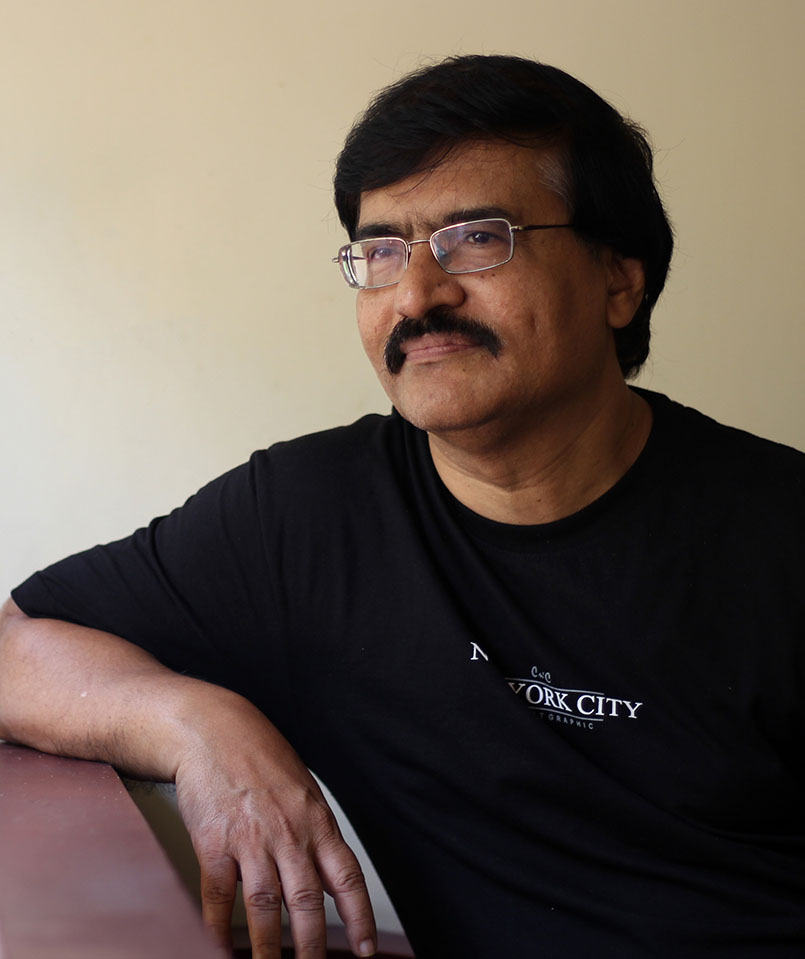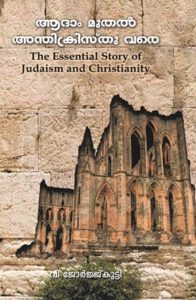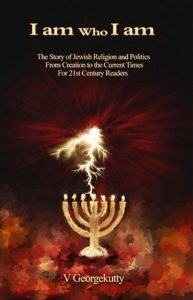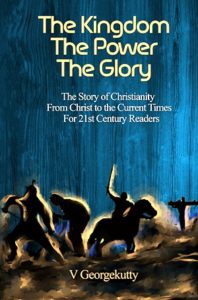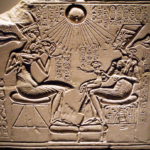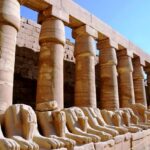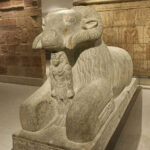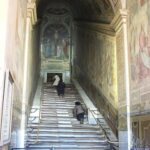“Every time someone ends a prayer in the Western world they say Amen – that is the name of an Egyptian god associated with completion. So we’re still praying to their gods.” (Whitley Strieber)
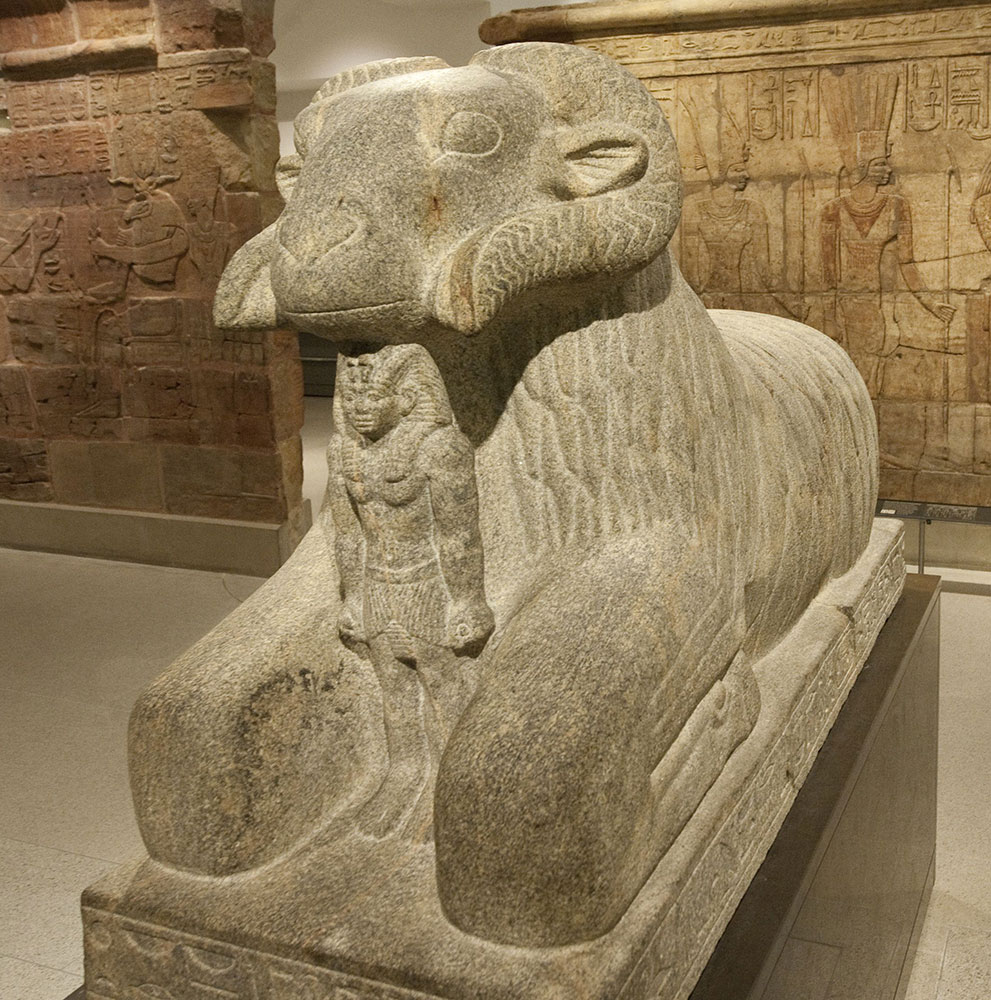
Granite statue of god Amen in the form of a ram
All of the major Egyptian deities are lords of towns, and each of the major towns or cities is the realm of a specific deity. A major city is a sacred city inasmuch as a major deity is the ruler of a city. The sky and the Nile had remained the chief divinities of Egypt. The sky itself was a vault, across whose vastness a great cow stood, who was the goddess Hathor. The earth lay beneath her feet, and her belly was clad in the beauty of ten thousand stars. In another version, the sky was the god Sibu, the earth was the goddess Nuit. All things had been born from their gigantic copulation. Constellations and stars might be gods. For example, Sahu and Sopdit (Orion and Sirius) were tremendous deities; Sahu ate gods three times a day regularly. Some such monster occasionally swallowed the moon – the Egyptian explanation of Lunar Eclipse. But soon the prayers of men and the anger of the other gods forced the greedy sow to vomit it up again!
To the Egyptian as in other ancient cultures, the heavenly bodies were the external forms of mighty spirits. The moon was, perhaps, the oldest of all gods worshiped in Egypt. But in the official theology the greatest of the gods was the sun. The sun was worshiped as the supreme deity Ra or Re – the bright father who fertilized Mother Earth with rays of penetrating heat and light. The sun god Re (later Amen-Re) represented the unified empire. Sometimes it was a divine calf, born anew at every dawn, sailing the sky slowly in a celestial boat, and descending into the west, at evening, like an old man tottering to his grave. Or the sun was the god Horus, taking the graceful form of a falcon, flying majestically across the heavens day after day as if in supervision of his realm…
God Re (sun) was always the Creator. At his first rising, Re saw the earth bare and desolate. He flooded it with his energizing rays and all living things sprung from his eyes. The earliest men and women were directly produced by Re. Obviously, they were perfect and happy. But by degrees their descendants took to evil ways to forfeit their perfection and joy. Re was angry and destroyed much of the human race. However, learned Egyptians asserted that the first men had been like brutes. It was all intelligent mythology and a pious expression of man’s gratitude towards nature.
Egyptians had worshiped not merely the source but also almost every form of life. Many plants were sacred to them. More popular were the animal gods. Egyptians had worshiped the bull, the crocodile, the hawk, the cow, the goose, the goat, the ram, the cat, the dog, the chicken, the swallow, the jackal, the serpent at various periods and locations. When the gods became human they still retained animal doubles and symbols: Amen (also spelled Amon, Amun) was represented as a goose or a ram, Ra as a grasshopper or a bull, Osiris as a bull or a ram, Sebek as a crocodile, Horus as a hawk or falcon, Hathor as a cow and Thoth, the god of wisdom, as a baboon. Sometimes women were offered to certain of these animals as sexual mates. From beginning to end this totemism remained as an essential and native element in ancient Egyptian religion. The goat and the bull were especially sacred to the Egyptians as representing sexual creative power. In Egyptian symbolism, the crux ansata – a cross with a handle – was a sign of sexual union and vigorous life.
At last the gods became human or rather, men became gods. Like the deities of Greece, the personal gods of Egypt were merely superior flesh and blood humans, made in heroic mould. They hungered and ate, thirsted and drank, loved and mated, hated and killed, grew old and died. For instance, there was Osiris, god of the beneficent Nile, whose death and resurrection were celebrated yearly as symbolizing the fall and rise of the river. Every Egyptian of the later dynasties could tell the story of how Set (or Sit), the wicked god of desiccation. He was angered at Osiris (the Nile) for extending (with its overflow) the fertility of the earth. Set slew Osiris and reigned in dry majesty over the slain god’s kingdom (i.e., the river once failed to rise). Then Horus, the brave son of Isis, overcame Set and banished him. The dead god Osiris was brought back to life by the warmth of the love of Isis. The risen Osiris thereafter ruled benevolently over Egypt, suppressed cannibalism, established civilization. Osiris eventually became the judge of the dead. It was a profound myth that portrays the dualistic nature of history. For history is a record of the conflict between creation and destruction, fertility and desiccation, rejuvenation and exhaustion, good and evil, life and death.
The myth of Isis, the Great Mother was no less profound. She was the loyal sister and wife of Osiris. But in a sense, she was greater than Osiris, for she had conquered death through love by bringing the dead Osiris back to life. She was also not merely the black soil of the Delta of river Nile, fertilized by the touch of Osiris (Nile). Her fertility was making all Egypt rich. Above all, Isis was the symbol of that mysterious creative power which had produced the earth and every living thing; and of that maternal tenderness and sacrifice whereby the young new life is nurtured to maturity.
The Egyptians had worshiped Isis with especial fondness and piety. They created her jewelled images as this Mother of God since she gave birth to god Horus, the god of the sun. Her tonsured priests praised and worshipped her. In the midwinter of each year, when the annual rebirth of the sun was celebrated (December 25), the temples of Horus (god of the sun), presented Isis in holy effigy nursing, in a stable, the infant Horus, whom she had miraculously conceived. These poetic-philosophic legends and symbols were later taken over by Christianity. The new faith transformed Horus the god of the sun into Jesus the Son of God, who too was miraculously conceived and had taken birth in a manger on December 25. Isis, the holy Mother of God (Horus) was made Virgin Mary, the Holy Mother of God (Jesus). Hallelujah! Merry Christmas!!
Re (or Amen as he was called in the South), Osiris, Isis and Horus were the greater gods of Egypt. In later days Ra, Amen and another god, Ptah, were combined as three embodiments or aspects of one supreme and triune deity – perhaps the source of the Christian Holy Trinity! There were countless lesser divinities: Anubis the jackal, Shu, Tefnut, Nephthys, Ket, Nut . . . Even Pharaoh was a god, always the son of Amen-Re, ruling not merely by divine right but by divine birth. On his head was the falcon, symbol of Horus and totem of the tribe. From his forehead rose the uroeus or serpent, symbol of wisdom and life, and communicating magic virtues to the crown. The king was chief-priest of the faith, and led the great processions and ceremonies that celebrated the festivals of the gods. It was through this assumption of divine lineage and powers that Egyptian kings were able to rule so long with so little force.
Egyptian religious faith was quite complex. Naturally, a class of people adept in magic and ritual, whose skill would make it indispensable in approaching the gods, had to arise. And a class grew up through the piety of the people and the political generosity of the kings. This priestly class became in time richer and stronger than the feudal aristocracy or the royal family itself. The sacrifices offered to the gods supplied the priests with food and drink; the temple buildings gave them spacious homes; the revenues of temple lands and services furnished them with ample incomes; and their exemption from forced labour, military service, and ordinary taxation, left them in an enviable position of prestige and power. They accumulated and preserved the learning of Egypt, educated the youth, and disciplined themselves with rigor and zeal. Eventually, this Egyptian priesthood became the model of Jewish and Christian priesthood!
Herodotus (485-425 BCE), the ancient Greek known as the father of history, describes the priestly class of Egypt, almost with awe: They are of all men the most excessively attentive to the worship of the gods, and observe the following ceremonies. . . . They wear linen garments, constantly fresh-washed. . . . They are circumcised for the sake of cleanliness, thinking it better to be clean than handsome. They shave their whole body every third day, that neither lice nor any other impurity may be found upon them. . . . They wash themselves in cold water twice every day and twice every night. (The priesthood of Judaism too had followed a more of less identical way of life.)
A distinguishing feature of Egyptian religion is its emphasis on immortality. If Osiris, the Nile, and all vegetation, could die and rise again, there was no reason why dead humans would not follow suit. The amazing manner in which dead bodies happened to be preserved in the dry soil of Egypt lent some encouragement to this belief in the resurrection of the dead. And for thousands of years, this belief had dominated Egyptian faith. While Judaism has no specific concept of the resurrection of the dead, this Egyptian concept was adapted the Christian faith.
Egyptians had believed that the body was inhabited by a small replica of itself called the ka and also by a soul that dwelt in the body like a bird flitting among trees. All these three components of human life – body, ka and soul – could escape mortality, as long as the flesh could be preserved from decay. But if they came to Osiris, the ruler of the realm of the dead, clean of all sin, they would be permitted to live forever in the heavenly gardens where there would always be abundance and security! Christianity happily embraced this consoling dream of an afterlife paradise!! Truly, the poor are blessed for they shall inherit the Kingdom of Heaven…
In the Egyptian mythology, the dead could reach the heavenly gardens only through the services of a ferryman. This old gentleman would receive into his boat only such men and women as had done no evil in their lives. Or Osiris would question the dead, weighing each candidate’s heart in the scale against a feather to test his truthfulness. Those who fail in this final examination would be condemned to lie forever in their tombs, hungering and thirsting, fed upon by hideous crocodiles…
But, with the powerful priesthood around, there must be a way out for the sinners. Egyptian priests had clever ways for passing these tests conducted by Osiris. One of the ways was to fit up the tomb with food, drink and servants to nourish and help the dead. Another was to fill the tomb with talismans pleasing to the gods: fish, vultures, snakes, above all, the scarab—a beetle which, because it reproduced itself apparently with fertilization, typified the resurrected soul. If these talismans were properly blessed by a priest, they would frighten away every assailant, and annihilate every evil. A still better way was the Book of the Dead – scrolls for which the priests had written prayers, formulas and charms calculated to appease, even to deceive, Osiris. Of course, these special tricks to gain entry into heaven were available only for appropriate considerations to the priests.
For the most part, Egyptian religion had little to say about morality; the priests were busier selling charms, mumbling incantations, and performing magic rites than inculcating ethical precepts. Even the Book of the Dead teaches the faithful that charms blessed by the clergy will overcome all the obstacles that the deceased soul may encounter on its way to salvation and eternal life. The emphasis is rather on reciting the prayers than on living the ethical life. Amulets and incantations were designed and sold to cover a multitude of sins that it could secure the entrance of the Devil himself into Paradise! The gods themselves used magic and charms against one another.
The literature of Egypt is full of magicians – of wizards who dry up lakes with a word, or cause severed limbs to jump back into place, or raise the dead. The king had magicians to help or guide him; and he himself was believed to have a magical power to make the rain fall, or the river rise. The same way, Jewish kings had prophets in their courts. Life was full of talismans, spells, divinations; every door had to have a god to frighten away evil spirits or fortuitous strokes of bad luck
Herodotus says, “Each day and month is assigned to some particular god; and according to the day on which each person is born, they determine what will befall him, how he will die, and what kind of person he will be.” In the end the connection between morality and religion tended to be forgotten; the road to eternal bliss led not through a good life, but through magic, ritual, and generosity to the priests.
An Egyptologist expresses the situation as follows: The dangers of the hereafter were now greatly multiplied, and for every critical situation the priest was able to furnish the dead with an effective charm which would infallibly cure him. Besides many charms which enabled the dead to reach the world of the hereafter, there were those which prevented him from losing his mouth, his head, his heart and so on, which enabled dead to remember his name, to breathe, eat, drink, avoid eating his own foulness, to prevent his drinking-water from turning into flame, to turn darkness into light, to ward off all serpents and other hostile monsters, and many others. . . . Thus, morality had no significance. The priests had access to all the tricks to make you clean as a whistle, at a price!
Such was the state of religion in Egypt when Pharaoh Ikhnaton (also spelled Akhenaton, Akhenaten, Akhnaton), came to the throne (r. 1353–36 BCE). Egyptian society was fundamentally polytheistic. But, this saintly man inaugurated the religious revolution in the form of monotheism. And it triggered the decline and fall of the mighty Egyptian Empire.
(We will discuss the story of Ikhnaton in the next post.)
